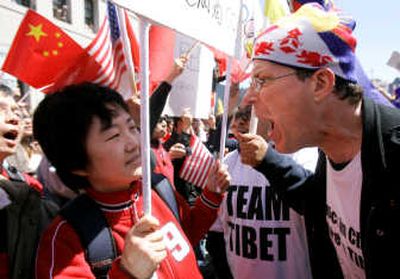In San Francisco, torch takes convoluted path

SAN FRANCISCO – The threat of large-scale protest turned what was to have been a dramatic passing of the Olympic torch Wednesday into a bizarre game of hide-and-seek, with officials hustling the flame onto a secretive and meandering route that baffled and angered many would-be spectators.
In the end, it was not clear who were the biggest losers – the city’s vast and proud population of Chinese Americans, the throngs of activists protesting China’s human rights record, or taxpayers saddled with the bill for police overtime.
Officials worried that the relay’s only North American stop would mirror the chaos and arrests that marked previous stops in London and Paris. So they employed a bait-and-switch tactic with thousands of activists who surged into the city to have their say on the political footprint China is leaving on international affairs – from Tibet to Myanmar to Darfur.
In a television interview, San Francisco Mayor Gavin Newsom defended the decision to change the route, saying it was done to protect the torchbearers and the public. Still, several torchbearers dropped out, apparently fearing for their safety.
On a day when nearly every San Francisco law enforcement officer was on duty, there were several scuffles and a small number of arrests, officials said. Protesters swarmed and vandalized a charter bus involved in the event, breaking a mirror and spray-painting “Free Tibet” on it in red.
At one point while carrying the torch, New York environmentalist Majora Carter said she unfurled a small Tibetan flag she had hidden up her sleeve. She said she was immediately shunted to the side of the route by Chinese security – known as torch-minders – who have accompanied the flame to every stop.
“Obviously, it didn’t go on as we expected,” Newsom said, adding that he was “pleased” with the outcome.
“Everyone was safe. The torchbearers were safe. The protesters were safe,” he said, adding that the decision to change the route was made after clashes occurred between pro-Chinese and pro-Tibet groups before the torch run’s scheduled start. “We had one of two choices,” the mayor said. “We could cancel the event outright or we could resolve this by adjusting the route. That was the assessment I made to keep people safe.”
One local official gave Newsom a stinging rebuke. Aaron Peskin, president of the county Board of Supervisors, characterized the last-minute route change as “chicanery and trickery that was designed to give the government of China what it wanted, a success.”
He said in a televised interview that protesters gave no indication they meant violence: “I would like to believe the mayor that this decision was made in real time. But I believe it was scripted well in advance.”
Activists also weren’t buying it. “I just wonder why the torch was running away from the people – wasn’t this an event to give citizens of the world a chance to see the Olympic flame?” asked Jerry Fowler, president of the Save Darfur Coalition. “Our goal was to exercise our right of free speech … and not take part in a mindless glorification of China holding the Olympics.”
Olympic officials endorsed the city’s actions.
The torch’s next scheduled stop is in Buenos Aires, Argentina, on Friday.
The relay came on a day when China faced more pressure from world leaders threatening an Olympic boycott. In London, British Prime Minister Gordon Brown said he would not attend the opening ceremony. German Chancellor Angela Merkel also said she would not attend.
In San Francisco, the relay devolved into one big diversionary tactic. The flame arrived late for its 1 p.m. unveiling, blazing briefly on a breezy outdoor stage near downtown. The torch carrier then ran from the podium, passed a statue of former San Francisco Giant Willie McCovey and vanished into a nearby building.
At first, a mayoral spokesman said the torch would be carried by boat. A police craft was tied up nearby, and officers on personal water craft zipped alongside it. News helicopters hovered near it. But the boats played no role in the relay.
The torch reappeared across town sometime after its first disappearance, under heavy security. Demonstrators soon caught on, prompting numerous run-ins with police, who on occasion shoved them aside to clear the way for the torchbearers.
The games continued. The route was shifted, the run truncated and the scheduled closing celebration abruptly canceled. City officials said the civic goodbye would be held at an undisclosed location. By 4 p.m., a bus carrying the torch was seen heading toward the airport.
An hour later, local TV stations reported that a secretive closing ceremony was taking place at San Francisco International Airport – apparently attended by a small group of officials and torchbearers.